An eggy, umami rice bowl is my favorite Japanese breakfast of all time! And there’s no wizardry required. I make tamago kake gohan with just two base ingredients (rice and egg) and a few toppings. If all recipes were this easy, I’d be out of a job.
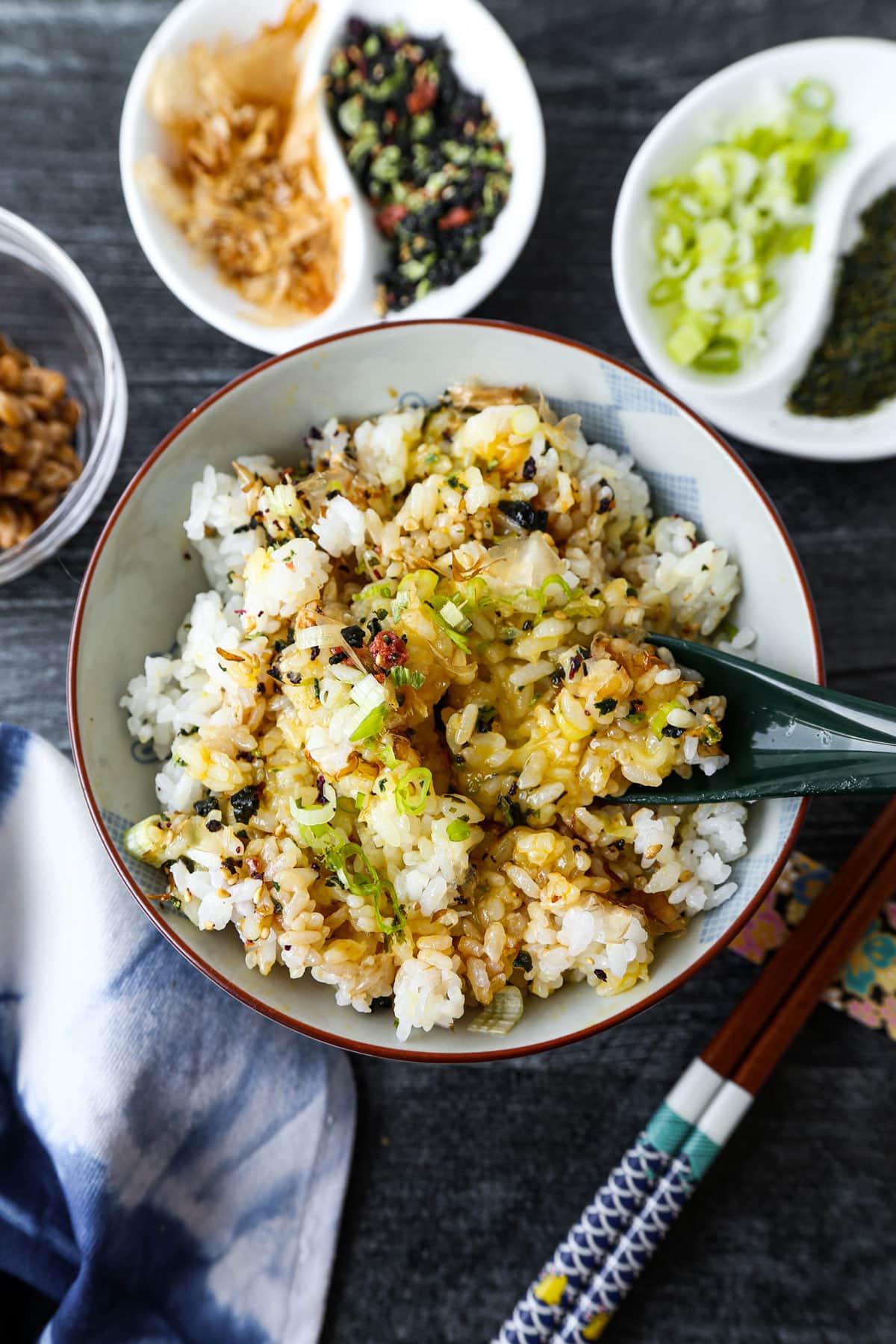
I don’t rock the boat with some things. Tamago kake gohan is a combination of Japanese rice with a raw egg. I make it by simply cracking an egg over a steaming bowl of rice and then beating the rice with chopsticks so the mixture takes on a slick, almost foamy consistency. The egg slightly thickens as it is beaten, due to the heat from the rice. It has been that way for hundreds of years, and I stick to that tradition to this day.
Then I augment the overall flavor (and texture) by adding toppings. Sometimes I go for a simple dash of soy sauce – and sometimes I prefer to go all out with things like homemade furikake and green onions – and once in a while even natto (fermented soybeans).
Tamago is egg in Japanese. Kake translates to something akin to splashed (similar to bukkake udon). And gohan is rice.
Table of Contents
Why I Love This
This is one of those recipes that’s directly linked to the flavors of my childhood. Every time I make it, I’m reminded of the simple lessons I learned about food as a kid from my mom. The first rule was that I wasn’t supposed to add soy to a bowl plain Japanese rice – unless it was for tamago kake gohan. It’s a rule I follow to this day. I’ll only pour soy sauce on virgin white rice for TKG.
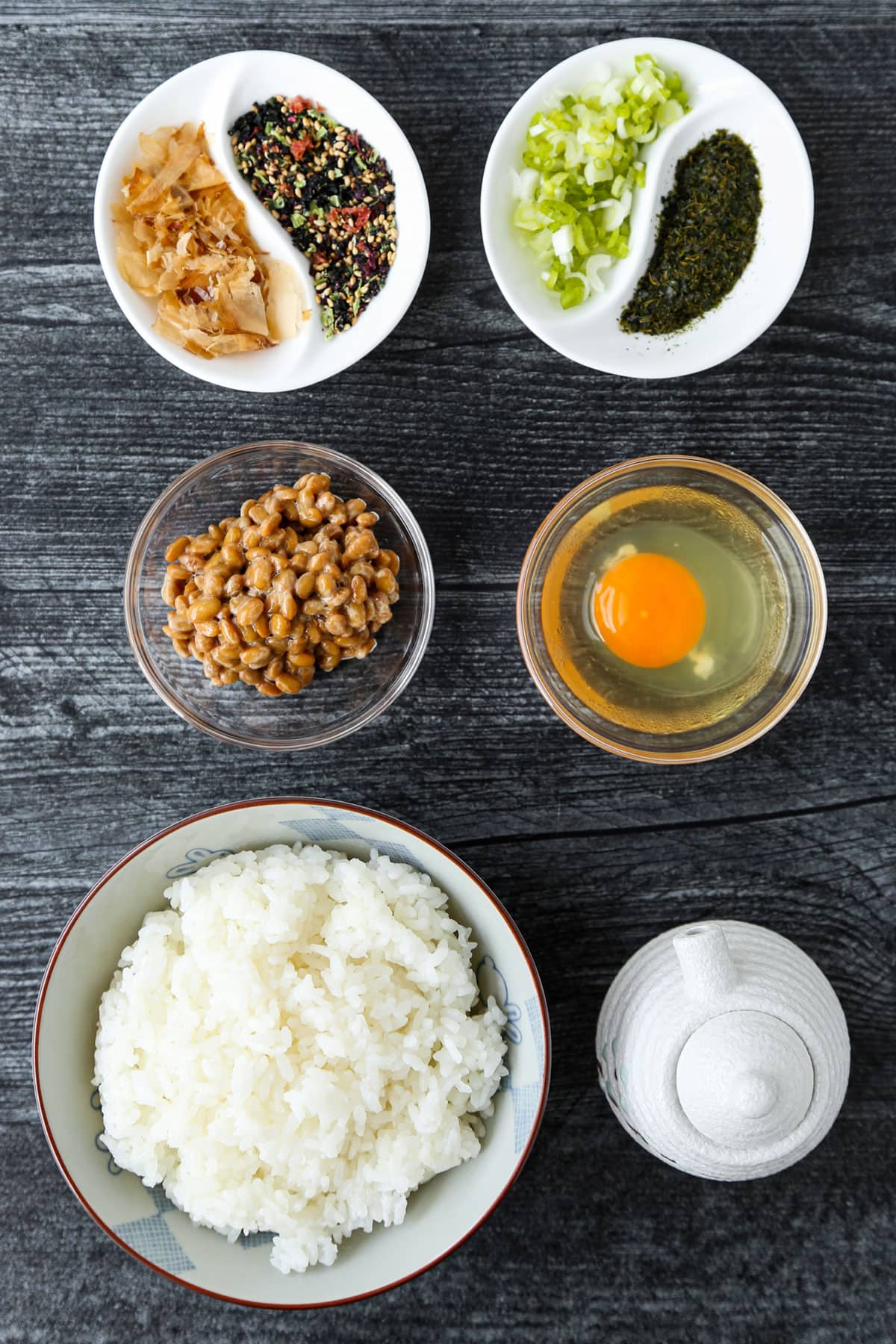
Ingredients
Scroll to the bottom of this page for the full recipe steps and measurements.
The bare bones of this dish are super simple. Take the toppings out of the equation for a second, and here’s what I use.
- Rice: I use Japanese short grain rice to be specific. The plump grains hold together with a slight clingy stickiness when properly cooked.
- Pasteurized Eggs: Look for pasteurized eggs with clean, unbroken shells.
Those are the basics.
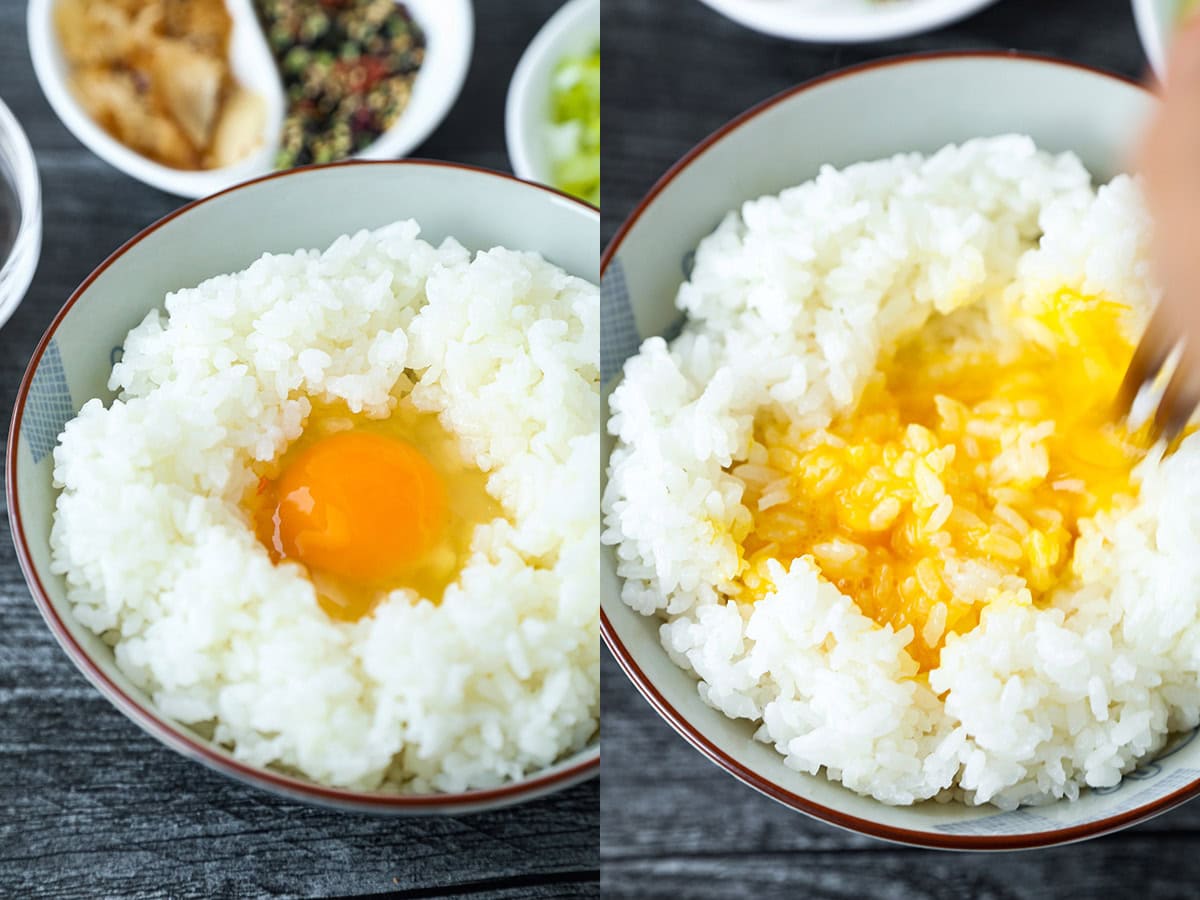
Toppings
One of my favorite parts of making TKG is playing around with different toppings until I find my sweet spot. Here are some of my go-to sauces and toppings:
- Soy Sauce: Instant umami.
- Tsuyu: Tsuyu is a concentrated broth I typically dip my zaru soba or somen noodles in before slurping away. But it also makes the perfect smoky, umami and slightly sweet addition to TKG. (Note: I only use tsuyu OR soy sauce. Not both.)
- Furikake: I make this Japanese rice seasoning with bonito flakes, seaweed, sesame seeds and a few spices. Furikake a savory, sweet wonder-condiment. Easy to make at home or buy premixed.
- Bonito Flakes: Katsuobushi is bonito or skipjack tuna that has been fermented, dried and shaved into flakes. One of my favorite savory ingredients. Easy to find these days in Asian supermarkets – or grab katsuobushi online.
- Shirasu: Also called whitebait, these are baby sardines or anchovies – and come in dried and raw variations.
- Natto: Funky fermented soybeans.
- Aonori or Seasoned Nori: Aonori is dried green laver (seaweed) that has been dried and powdered.
- Green Onions: For a verdant crunch.
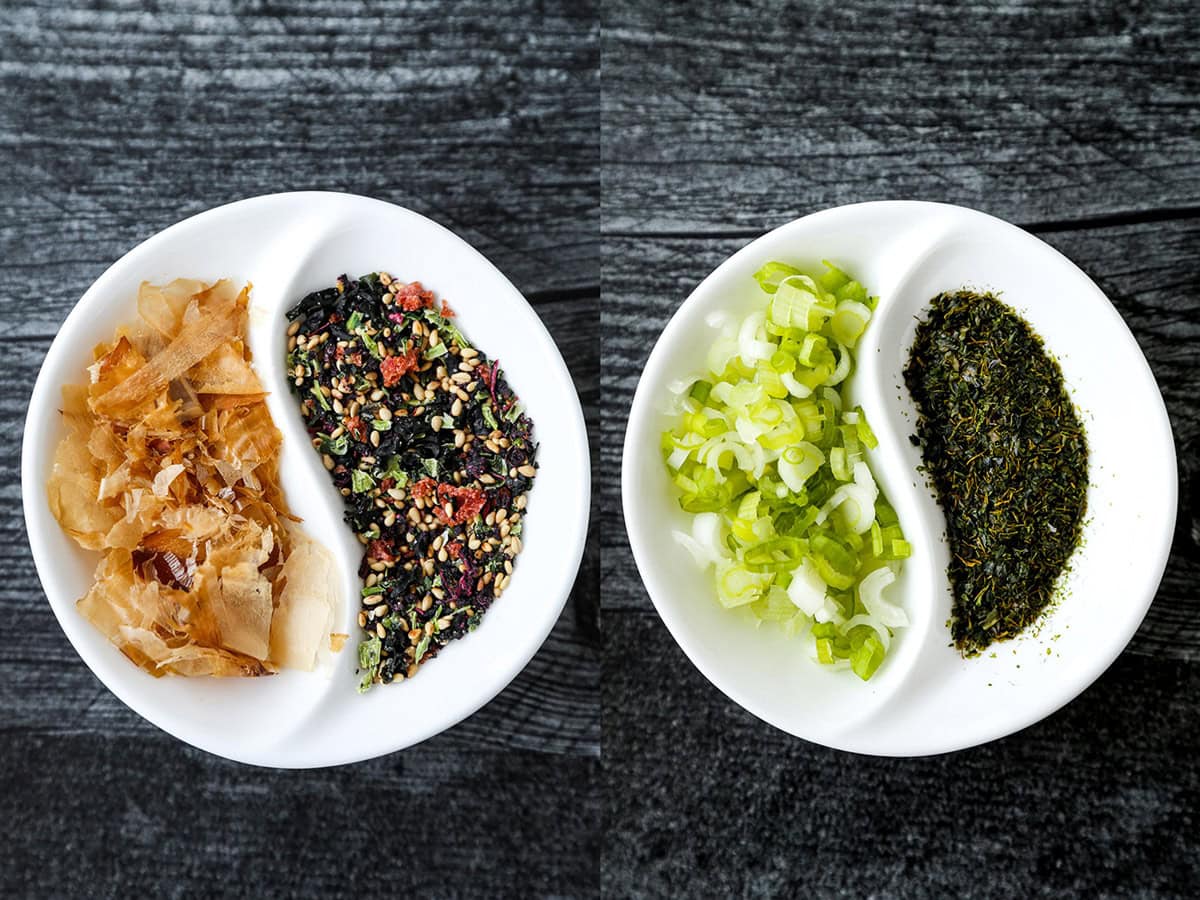
How to Make It
- Portion the rice. Place the hot, cooked Japanese rice in a rice serving bowl and make an indentation in the top of the rice with your rice paddle or a spoon.
- Add the egg and toppings. Cleanly break an egg and pour into the dented space. I add my toppings and seasonings at this point too.
- Mix. Quickly stir the egg (and toppings) and incorporate the egg into the rice. Mix it well, until almost frothy. Eat immediately
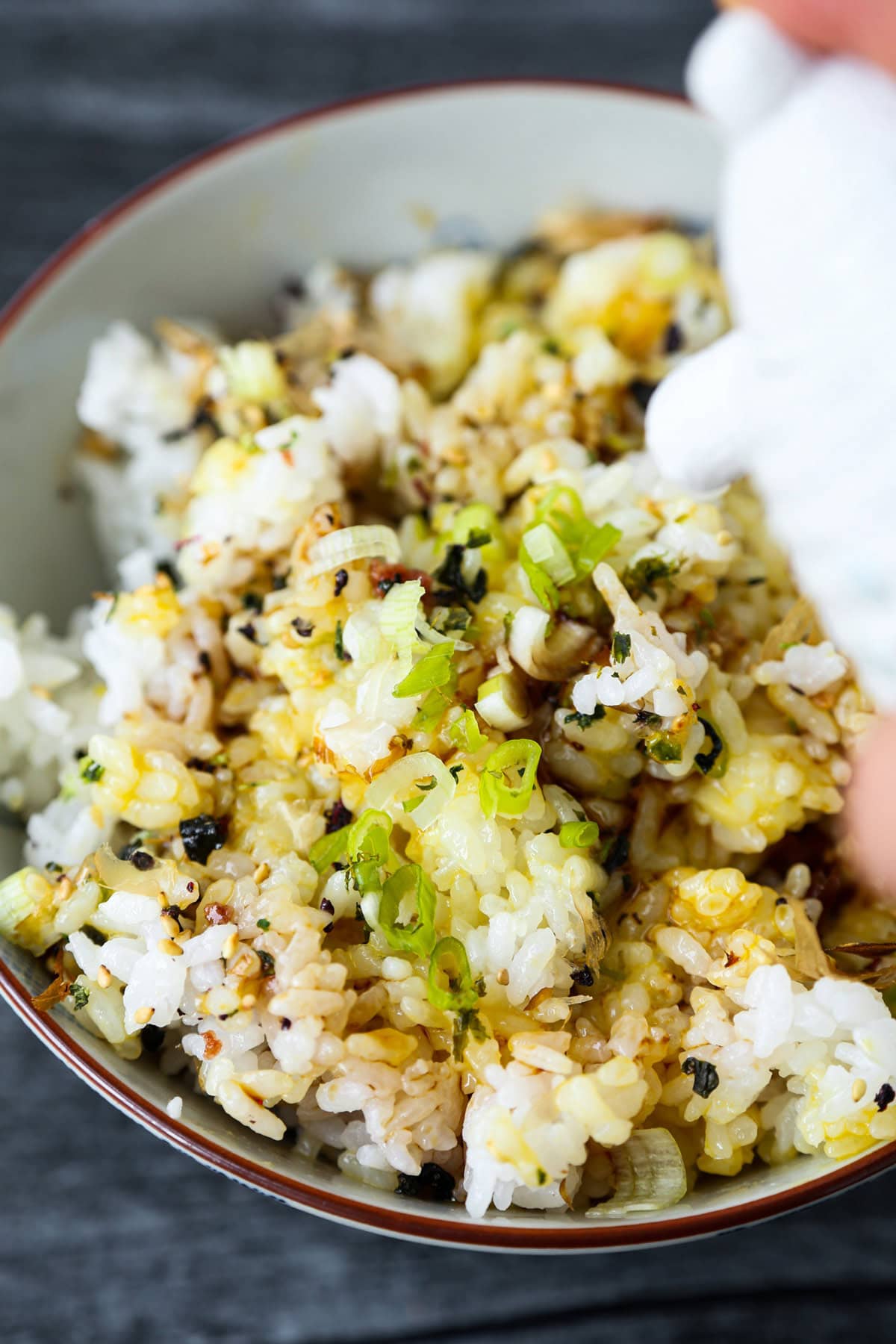
Expert Tip
Make the rice ahead of time. Since this is technically a breakfast recipe, the last thing I want to do first thing in the morning is make a batch of steamed rice before I’ve even had my first cup of coffee. If you have a rice cooker, this is easy. Just make the rice the night before and the keep warm function will do its thing. No rice cooker, no problem. Make Japanese rice on the stovetop – and store in a covered tupperware in the refrigerator. Microwave the rice to reheat thoroughly.
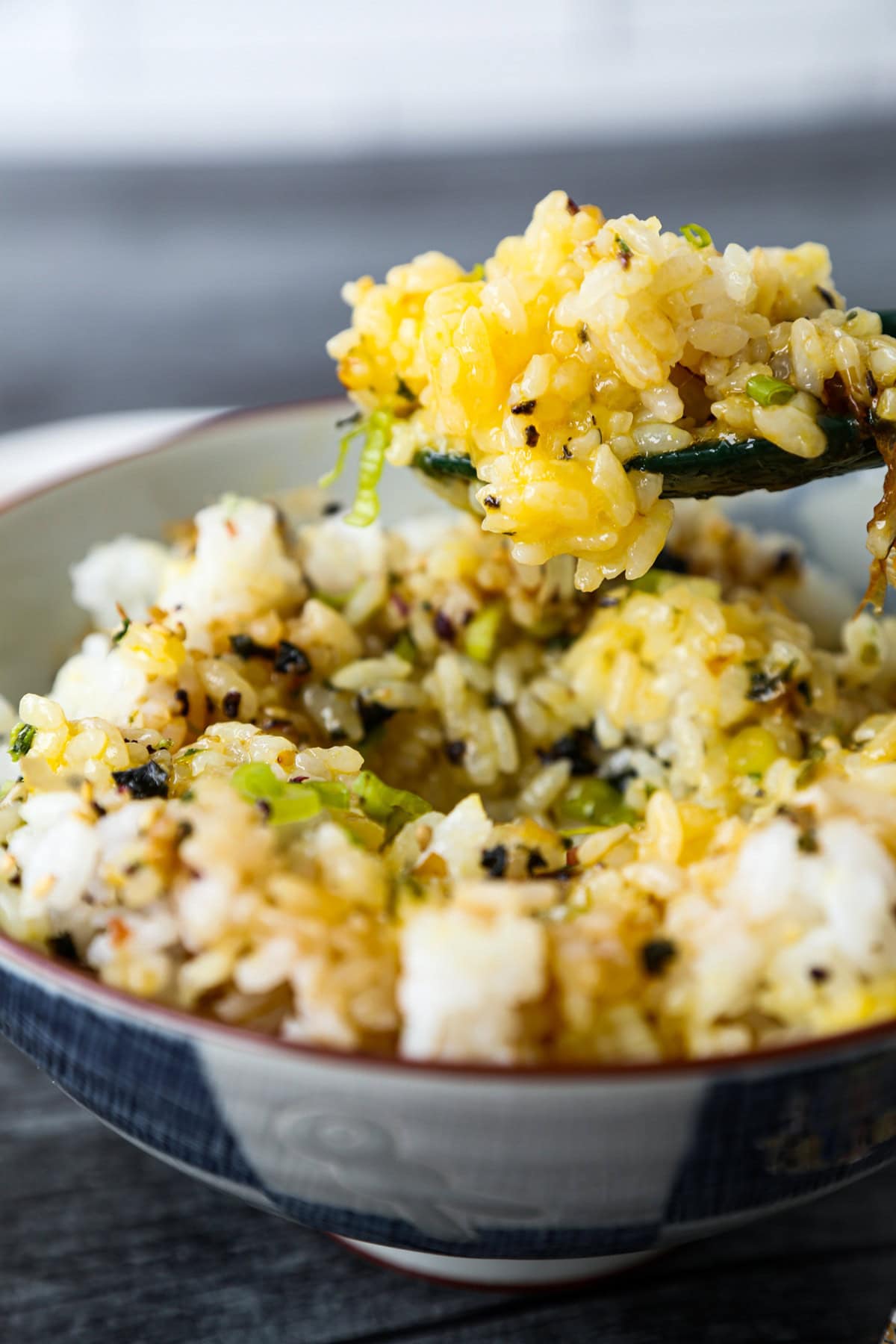
Storage
Do not save tamago kake gohan leftovers. Once the egg and rice are mixed, it should be eaten immediately.
What I Serve With Tamago Kake Gohan
TKG is a one-bowl-wonder. Sometimes it’s all I need in the morning. But Japanese breakfast can go a lot of ways. Here are a few of my breakfast favorites.
- Shiozake – Japanese Salted Salmon
- My Mom’s Miso Soup
- Hiyayako – Chilled Tofu With Toppings
- Japanese Egg Drop Soup – Kakitamajiru
- Japanese Pancakes (Hot Cakes – ホットケーキ)
Frequently Asked Questions
Not really. You’re going to want to use Japanese short grain rice when making tamago kake gohan. These grains are plump and chewy and hold together with a slight clingy stickiness. (But it is not sticky rice. That’s another type of rice altogether). Now, some of what you’ll find on the shelves at your local supermarket sold as Japanese rice is actually medium grain rice. And while we sometimes just have to use what we can get our hands on, I’m a big fan going the extra mile when it comes to rice. My favorite all-purpose Japanese premium short grain rice is Tamanishiki. It’s perfect for everything from this TKG to curry rice to maki.
You might be wondering why this dish is so common in Japan, even though eating raw eggs is synonymous with potentially contracting a foodborne illness. Japanese eggs only make it to market after undergoing a strict regiment of inspection, cleansing, sterilization and drying. This obliterates even the slightest traces of bacteria that can cause salmonella poisoning. These steps are governmentally regulated in Japan – and the public tends to have quite a bit of confidence in consuming raw eggs there. In the States, some eggs in the refrigerated case at your local store have been pasteurized – meaning they have been heated in their shell to a certain temperature to kill bacteria (without actually cooking the egg itself). However, some are not. Luckily, in the US, eggs that are pasteurized are clearly marked accordingly on their container. Use pasteurized eggs for TKG.
Did you like this recipe? Are there changes you made that you would like to share? Share your tips and recommendations in the comments section below!
Print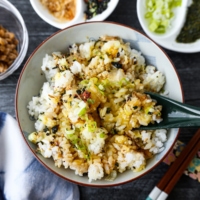
Tamago Kake Gohan
- Prep Time: 10 minutes
- Cook Time: N/A
- Total Time: 10 minutes
- Yield: 2 1x
- Category: Rice
- Method: Mixed
- Cuisine: Japanese
- Diet: Vegetarian
Description
My favorite Japanese breakfast! I make tamago kake gohan with two base ingredients and a few toppings. A fluffy, eggy rice bowl packed with umami!
Ingredients
- 2 cups warm, cooked Japanese short grain rice
- 2 pasteurized eggs, such as Davidson’s Safest Choice
Suggested toppings
- Soy sauce
- Tsuyu
- Furikake
- Bonito flakes
- Shirasu (whitebait)
- Natto
- Aonori or seasoned nori
- Chopped scallions
Instructions
- Portion the rice. Divide the cooked rice among two bowls. Create a little dent in the center of the rice, where the egg will sit.
- Add the egg and toppings. Break each egg into the dented space and add the seasoning and topping(s) of your choice.
- Mix. Quickly stir the egg using chopsticks and mix it with the rice, along with the toppings. Don’t be afraid to make a mess!
- Serve. Add more toppings if desired and eat immediately.
Notes
TGK should be eaten immediately. Once mixed, do not store leftovers.
Nutrition
- Serving Size: 1 cup with egg
- Calories: 313
- Sugar: 0.2g
- Sodium: 71mg
- Fat: 5.1g
- Saturated Fat: 1.7g
- Unsaturated Fat: 1.1g
- Trans Fat: 0g
- Carbohydrates: 53.5g
- Fiber: 0g
- Protein: 10.7g
- Cholesterol: 186mg















Thanks for the recipe.